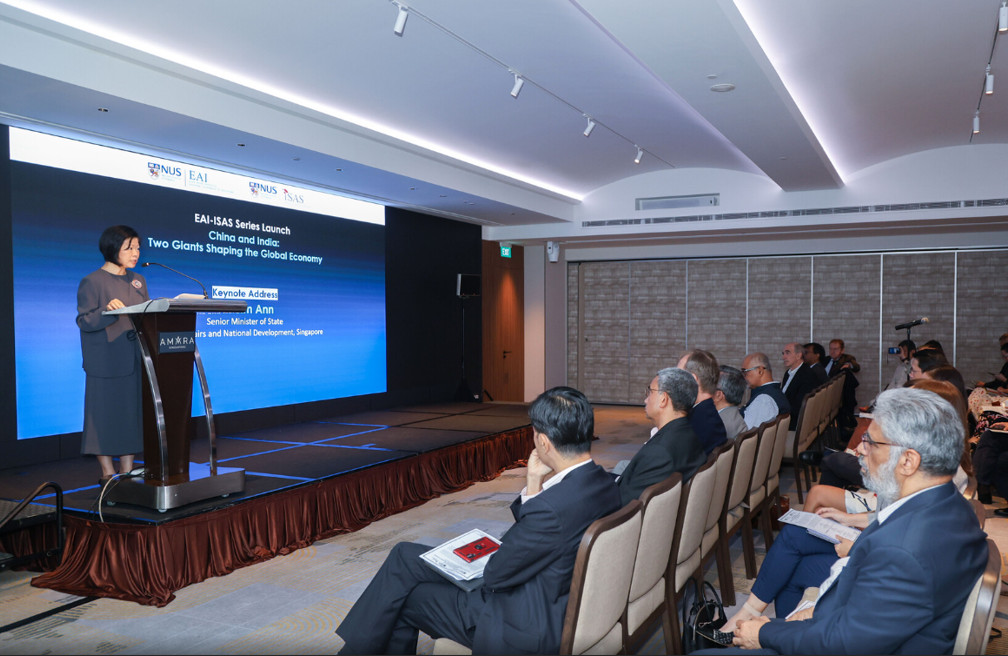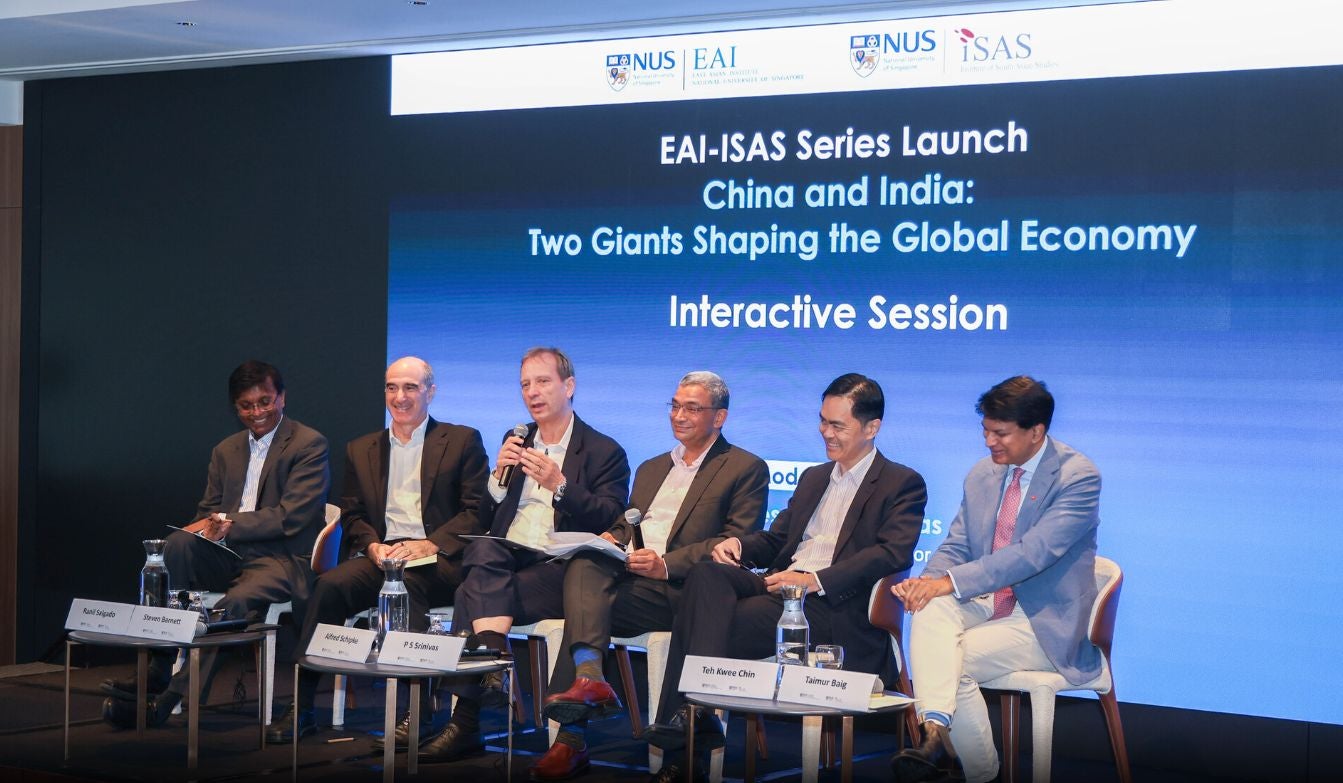EAI-ISAS Series Launch: 14 November, 2024
The East Asian Institute (EAI) and the Institute of South Asian Studies (ISAS) at the National University of Singapore (NUS) launched a joint series examining key issues related to China and India and their roles in the global economy.
Senior Minister of State for Foreign Affairs and National Development Sim Ann delivered a keynote address during the event. She spoke about the significance of China and India as economic powerhouses and pivotal players on the global stage, and how Singapore and the region should continue to closely engage both countries, given their vital roles in regional growth and development.
Leading scholars, including Dr Li Li, Deputy Director of the Institute of International Relations at Tsinghua University, and Professor C Raja Mohan, Visiting Research Professor at ISAS, spoke on China and India in global order as well as their alignments. Other speakers included representatives from the International Monetary Fund as well as the public and private sectors.
The inaugural closed-door workshop under the series was held following the public launch event. Comprising panellists and participants from public and corporate sectors, academic and research fraternity from Singapore, China and India, the workshop discussed the impact of China’s recent economic policy announcements and the implications of the recent United States presidential election for China and India.
China and India: Two Giants Shaping the Global Economy
Overview
China and India, the world’s first and third-largest economies by purchasing power parity, wield immense global influence. Together, they account for 35 percent of the global population and are projected to contribute 50 percent of global economic growth in 2024. Their economies are key drivers of regional and global trade, deeply intertwined with supply chains and crucial to addressing global challenges like climate change. Both nations are also at the forefront of innovation in sectors such as financial technology. As members of BRICS, they advocate for reforms in global governance and the financial architecture to ensure fairer representation.
The launch would set the stage for a series of workshops and public events on China-India and the global economy, jointly organised by the East Asian Institute and the Institute of South Asian Studies at the National University of Singapore. Through a series of workshops and public events, this initiative will explore key issues related to China and India and their roles in the global economy. By bringing together academics, policymakers, practitioners and business leaders, these events will foster dialogue and provide deeper insights into the evolving influence of China and India on the global stage.
Programme
| Welcome Remarks | Associate Professor Iqbal Singh Sevea Director Institute of South Asian Studies, NUS |
| Introduction | Dr Teh Kok Peng Chairman East Asian Institute, NUS |
| Keynote Address |
Ms Sim Ann Senior Minister of State Foreign Affairs & National Development, Singapore |
| Stage Setting | |
| China and the Evolving Global Order |
Dr Li Li |
| The Evolution of India’s Multi-Alignment |
Professor C Raja Mohan |
| Presentations and Interactive Session | |
| Moderator | Professor P S Srinivas Visiting Research Professor East Asian Institute, NUS |
| The Global Economy and the Importance of China and India |
Professor Alfred Schipke |
| China’s Economic Outlook and Reform Priorities |
Dr Steven Barnett |
| India’s Economic Outlook and Reform Priorities |
Dr Ranil Salgado |
| Discussants |
Mr Teh Kwee Chin |
|
Dr Taimur Baig |
|
| Interactive Session and Q&A |
About the Chairpersons and Speakers (In Order of Presentation)
Highlights from the Event

Keynote Address – Speech by Senior Minister of State for Foreign Affairs and National Development Sim Ann
In her keynote address, Ms Sim stressed the need for Singapore and the region to closely engage both India and China and ensure that they remain constructive and valued partners in the region’s growth and development. She noted that Singapore can play a meaningful role in the growing economic activity within, between, and beyond China and India, by being keenly aware of our respective comparative advantages, and Singapore’s economic connectivity and global positioning.
Ms Sim also stressed the need to find ways to harness the engines of China and India effectively to propel our region forward amid growing great power competition, fragmentation, protectionism, and nationalism. She noted that as ancient civilisations with deep cultural memories and great ambitions, India and China will continue to be central drivers of global and regional growth. By virtue of their growing strategic and economic heft, China and India will seek more prominent roles in international affairs. They will increasingly exercise substantial influence over the future direction of global governance and geopolitical outcomes, even as they concurrently navigate complex relationships with other countries, near and far.
She noted that while China and India’s relations have encountered various ups and downs over the years, with both countries today competing for influence in South Asia and the Indian Ocean, and for leadership of the Global South, both countries have shown that they can manage their relationship pragmatically. Both countries reached an agreement on patrolling arrangements along the Line of Actual Control in Ladakh in October, paving the way for a meeting between President Xi Jinping and Prime Minister Narendra Modi on the sidelines of the BRICS Summit, their first formal meeting in five years.
In addition, Ms Sim noted the importance of a stable China-India relationship, highlighting how China and India are two power engines that would help the ASEAN region lift off. She added that China and India continue to recognize each other as neighbours with a long history of cultural and economic ties, and continue to work together in areas like climate change and education.
China and the Evolving Global Order – Dr Li Li, Deputy Director of the Institute of International Relations at Tsinghua University
Dr Li Li’s address focused on China’s role in the evolving global order, emphasizing its commitment to multipolarity and globalization. She highlighted China’s cautious stance on bipolarity, driven by its historical aversion to hegemonic dynamics and its recognition of a rising multipolar world with emerging powers like India and Brazil.
Dr Li highlighted recent narratives of China as a challenger to the rules-based liberal world order as “misunderstandings and misreadings”, pointing to its active engagement with global systems, such as the World Trade Organization, and its advocacy for economic interdependence.
She also discussed the complexities of China-India relations, shaped by great power competition and strategic alignments, but stressed the potential for cooperation in global governance and platforms like BRICS. In particular, the Global South provides an arena for both powers to cooperate.
Dr Li concluded her presentation by highlighting China’s openness to new initiatives which can stabilize the world and contribute to peace and prosperity, and emphasizing China’s commitment to the United Nations (UN) charters and the UN’s authority, major power cooperation as well as China’s ‘good neighbourhood’ principles of solving disputes through negotiations and peaceful means.
The Evolution of India’s Multi Alignment – Professor C Raja Mohan, Visiting Research Professor at the Institute of South Asian Studies
Professor C. Raja Mohan’s presentation explored the complexities of India’s evolving multi-alignment strategy amidst its dynamic relationship with China. He emphasized the asymmetry in economic and military power between the two nations, with China being significantly ahead in terms of military spending. Despite the existing security dilemmas, with China viewing the Quad with suspicion, and India fearing that China is a bigger power, Prof Raja Mohan highlighted the importance of identifying ways for both countries to peacefully co-exist as large neighbours that share a region.
Prof Raja Mohan stressed India’s role as an independent power through the international system. Despite its strategic alignment with the Quad and the U.S., it has played a role in ensuring that the Quad does not become a military alliance. The country is also not a treaty ally of the United States. This, he noted, should give confidence to China that India is not going to join hands with the US to contain China.
He also highlighted how India’s substantial trade deficit of nearly USD 100 billion with China has generated debate within India about how to deal with this trade imbalance and continues to pose challenges to economic collaboration between the two countries despite the potential for greater economic synergy between both countries. Prof Raja Mohan stressed that while India will continue to grow and become a significant economy, it will not replicate China’s economic model.
Lastly, he highlighted the importance of mutual accommodation to shape a stable, prosperous regional order in Asia, especially as global economic structures shift amidst U.S.-China tensions.
The Global Economy and the Importance of China and India – Professor Alfred Schipke
Slides: “The Global Economy and the Importance of China and India” by Professor Alfred Schipke
Professor Alfred Schipke’s presentation explored China and India’s critical roles as drivers of global economic growth, with their combined contributions accounting for about half of the projected global growth in 2024.
He highlighted the shared challenges and opportunities both two nations face, including climate change, financial system reforms, and technological leadership in fintech and digital innovation. Both countries have grievances regarding their underrepresentation in global governance structures like the IMF and at the same time, are increasingly shaping alternative systems such as BRICS.
Despite differences in economic structures and development, China and India exhibit similarities in their development goals, industrial policies, and financial system characteristics. Prof Schipke emphasized the growing interdependence between the two nations through trade, investment, and labour flows, concluding that collaboration between them is essential for addressing global challenges and fostering sustainable economic growth.
China’s Economic Outlook and Reform Priorities – Dr Steven Barnett
Slides: “China’s Economic Outlook and Reform Priorities” by Dr. Steven Barnett
Dr Steven Barnett’s presentation highlighted the resilience of the Chinese economy amidst significant challenges. He emphasized China’s substantial contribution to global growth, accounting of nearly 28% of it in 2023.
Despite a slowdown, China’s GDP growth remains significant, reflecting its robustness even amidst real estate market corrections. Dr Barnett stressed two major long-term challenges: boosting productivity through structural reforms and increasing household consumption as a share of GDP. He noted the importance of redirecting resources efficiently and fostering innovation, especially in the services sector. While China’s consumer market has grown rapidly, household consumption as a GDP percentage remains low. Policies to increase disposable income and lower savings rates are critical.
Dr Barnett concluded that strengthening consumer confidence and enacting strategic reforms are essential for sustaining China’s economic momentum and addressing future challenges.
India’s Economic Outlook and Reform Priorities – Dr Ranil Salgado
Slides: “India: Economic Outlook and Reform Priorities” by Dr. Ranil Salgado
Dr Ranil Salgado’s presentation highlighted India’s role as a key engine of global growth, supported by prudent macroeconomic policies and significant public infrastructure investment.
He emphasized the potential of India’s demographic dividend, while pointing out the challenges in creating high-quality jobs and boosting private investment. India’s economic growth remains robust, with a projected long-term rate of 6.5-7%, but achieving India’s target to become an advanced economy by 2047 requires further acceleration.
Key recommendations included sustaining fiscal consolidation, enhancing revenue mobilization, and addressing vulnerabilities in the financial sector.
Dr Salgado stressed the importance of structural reforms in education, skills development, and labour markets to maximize India’s growth potential. He also noted the need for resilient policies to manage inflation, enhance agricultural supply chains, and increase private sector participation to complement public investments.
Interactive Session

The interactive session, which also featured Dr Taimur Baig, Chief Economist, DBS Bank and Mr Teh Kwee Chin, Vice-President, GIC, delved into specific challenges and strategies for China and India in areas such as energy transition, trade policies, labour productivity, and manufacturing competitiveness:
- India’s Energy Transition: Questions focused on India’s ability to navigate its fiscal deficit and reliance on high tariffs for solar panel imports while expanding green energy. Panellists acknowledged India’s progress in solar energy, particularly in Gujarat and Maharashtra, but highlighted inefficiencies caused by tariffs on Chinese solar panels, which encourage indirect imports and distort trade flows. They emphasized the need for domestic competition and efficient industrial policies to sustain green energy growth.
- China’s Competitiveness and Consumption: Questions about China’s use of export rebates and balancing rising consumption with productivity were raised in relation to the country’s efforts to sustain its economic growth. Panellists noted that China’s green energy transition, particularly in solar and wind energy production, has become a transformative growth driver, helping to offset challenges like property market issues and tariff impacts.
- Future India-China Trade Relations: On trade, panellists discussed whether India’s manufacturing focus would rely on intermediate goods from China or shift toward greater self-reliance. They highlighted India’s production-linked incentive schemes to attract manufacturing investment but noted that labour market reforms and automation would play crucial roles in scaling up production.
- Inflation and Inequality: A question on India’s cost of living crisis and income inequality led to discussions on how inflation, at 30% above pre-crisis levels, impacts the average citizen. Panellists stressed the need for structural reforms in education, infrastructure, and labour markets to ensure inclusive growth.
- Green Transition in China: Questions were raised about the potential of China’s green transition as a key strategy for long-term growth. Panellists shared examples of Chinese firms transitioning from traditional industries to becoming leaders in wind turbines and energy storage, underlining China’s ability to foster innovation and drive sustainable industrial growth.
The session concluded with a consensus that both nations must address structural inefficiencies, foster innovation, and pursue reforms to achieve inclusive and sustainable economic progress while managing external challenges and global economic shifts.


